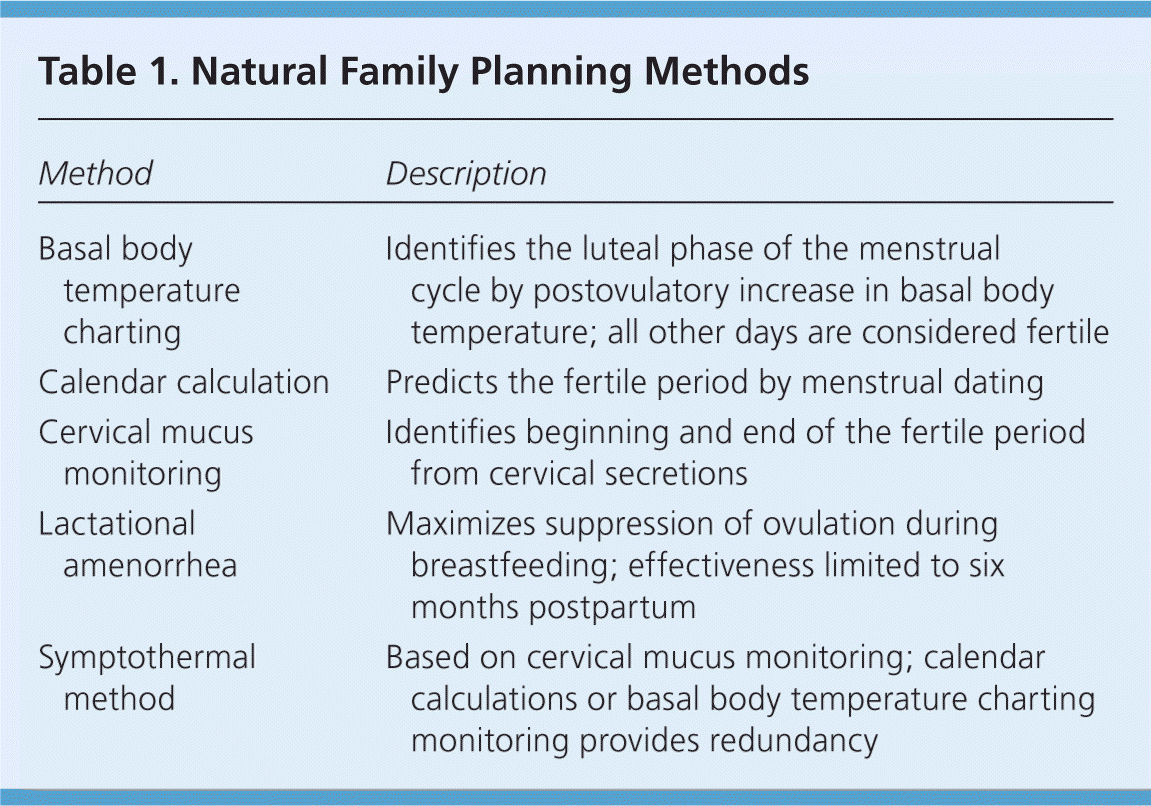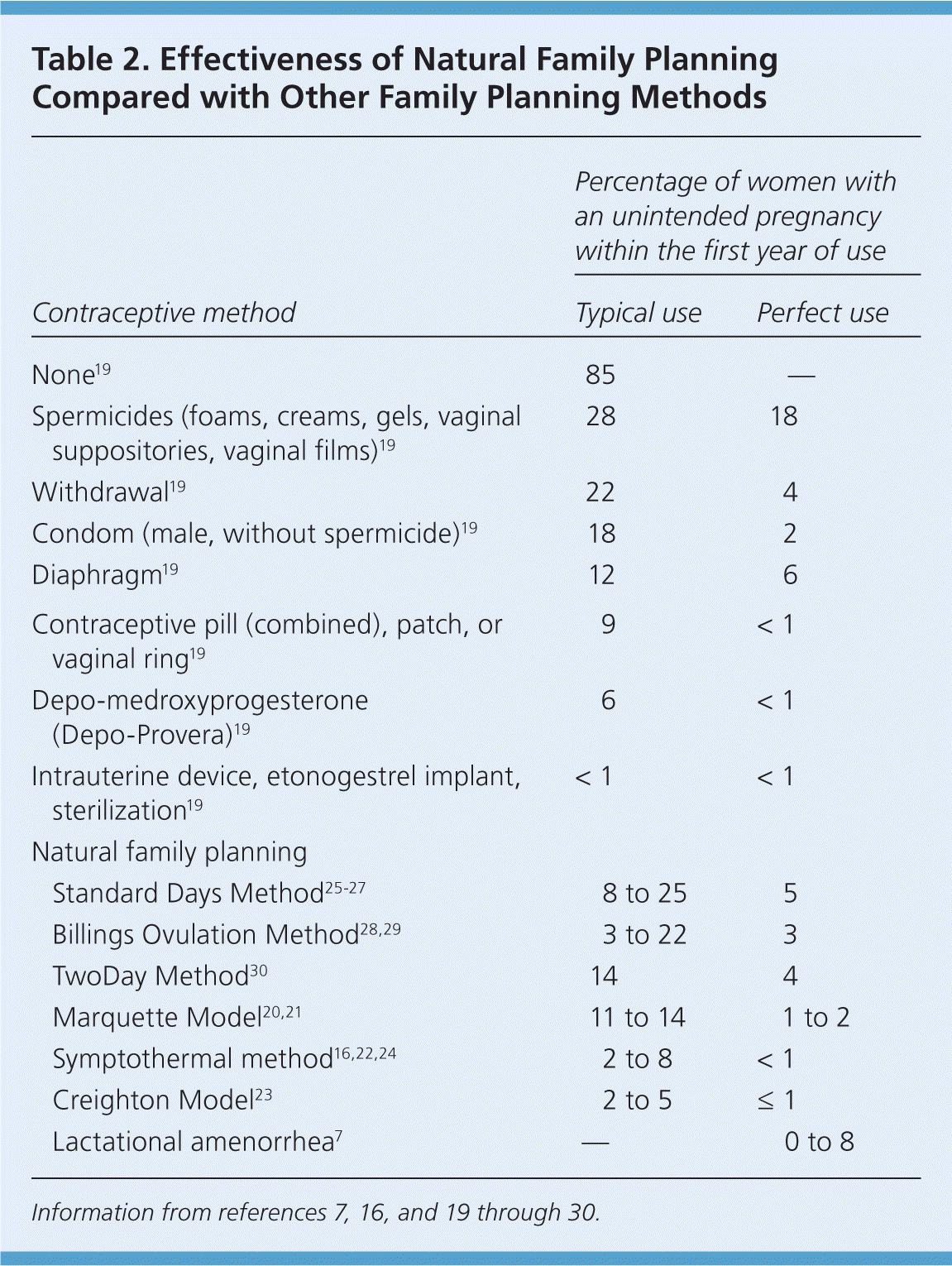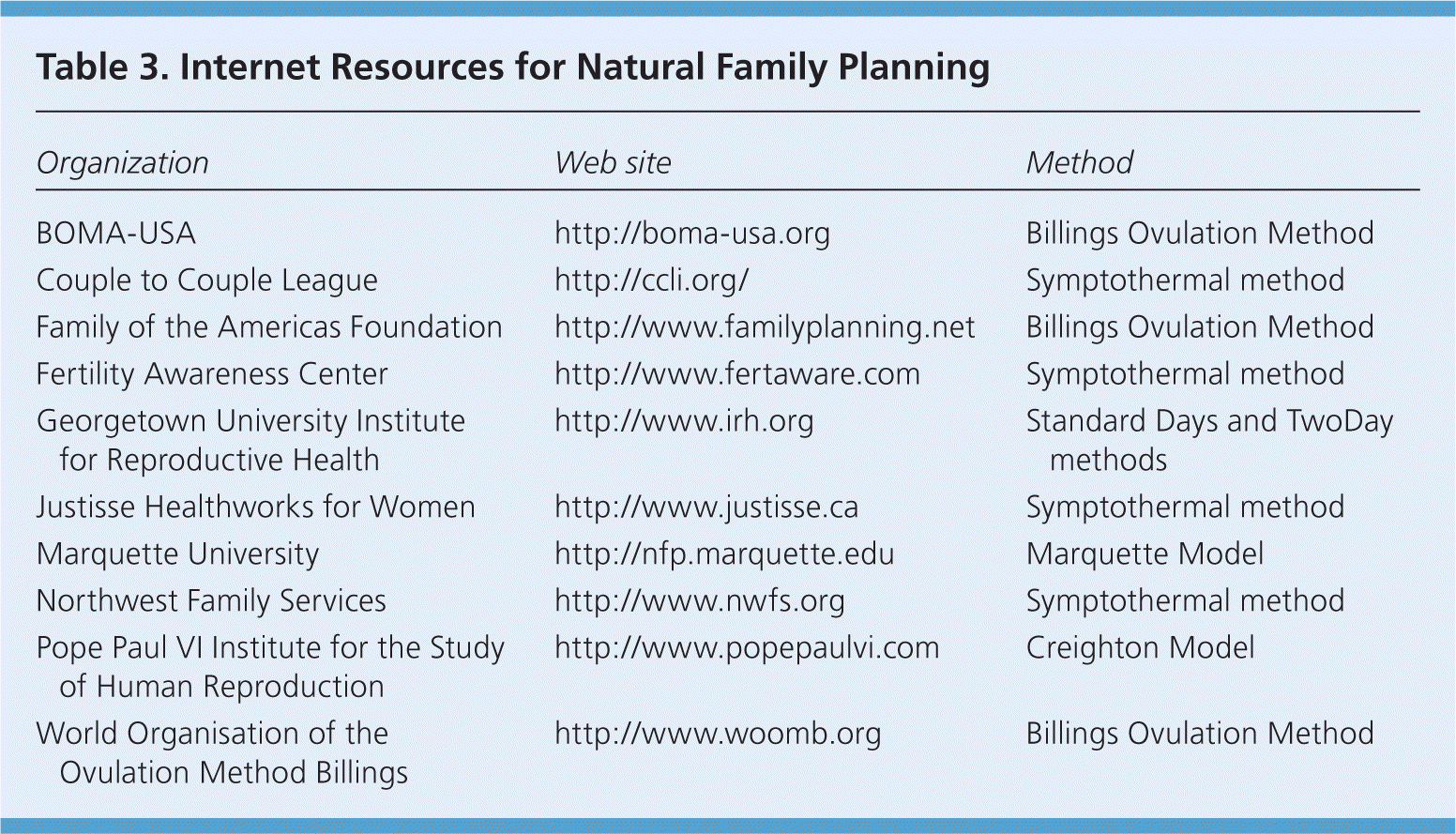
Am Fam Physician. 2012;86(10):924-928
Related editorials: Is Natural Family Planning a Highly Effective Method of Birth Control? Yes: Natural Family Planning is Highly Effective and Fulfilling and No: Family Natural Family Planning Methods Are Overrrated.
Related letter: Physicians Need More Education About Natural Family Planning
Patient information: See related handout on natural family planning, written by the authors of this article.
Author disclosure: No relevant financial affiliations to disclose.
Natural family planning methods provide a unique option for committed couples. Advantages include the lack of medical adverse effects and the opportunity for participants to learn about reproduction. Modern methods of natural family planning involve observation of biologic markers to identify fertile days in a woman's reproductive cycle. The timing of intercourse can be planned to achieve or avoid pregnancy based on the identified fertile period. The current evidence for effectiveness of natural family planning methods is limited to lower-quality clinical trials without control groups. Nevertheless, perfect use of these methods is reported to be at least 95 percent effective in preventing pregnancy. The effectiveness of typical use is 76 percent, which demonstrates that motivation and commitment to the method are essential for success. Depending on the method, couples can learn about natural family planning methods in a single office visit, through online instruction, or from certified instructors.
Family planning allows individuals and couples to anticipate and attain the desired number, spacing, and timing of children.1 Fertility awareness methods of family planning use one or more biologic markers to identify fertile days of a woman's reproductive cycle. Intercourse is avoided or a contraceptive method is used on these fertile days to avoid pregnancy. Conversely, couples desiring pregnancy are more likely to conceive if they have intercourse during this fertile period. Fertility awareness methods qualify as natural family planning (NFP) if they are used with periodic abstinence rather than an artificial contraceptive method.2–4
Although less than 1 percent of respondents to the 2006–2008 National Survey of Family Growth reported current use of NFP, 19 percent reported prior use of the rhythm method, and 5 percent reported prior use of some other NFP method.5 If asked for family planning information, one-half of physicians report that they would provide information about NFP to prevent pregnancy, and three-fourths would provide information about its use to achieve pregnancy.6 This article discusses methods, mechanisms of action, and demonstrated effectiveness of NFP to enable physicians to provide appropriate information and counseling to their patients.
| Clinical recommendation | Evidence rating | References |
|---|---|---|
| Lactational amenorrhea is 92 to 100 percent effective in preventing pregnancy during the first six months postpartum in women who exclusively breastfeed their infants, provided that menstruation does not resume. | B | 7 |
| With perfect use, modern natural family planning methods can be as effective in preventing pregnancy as hormonal contraceptives. | B | 16, 20–23, 25, 28–30 |
| The Creighton Model for cervical mucus monitoring and the symptothermal method are the most effective natural family planning methods currently available. | B | 16, 22–24 |
Methods and Mechanisms of Action
The five principal types of NFP are calendar calculation, basal body temperature charting, cervical mucus monitoring, the symptothermal method, and lactational amenorrhea4 (Table 1). The first four methods allow couples to plan intercourse around the days of increased fertility during the woman's reproductive cycle. In lactational amenorrhea, ovulation does not occur, and there are no fertile days. Use of this method is limited to women who are exclusively breastfeeding during the first six months postpartum, and applies only if menstruation has not resumed. When these conditions are met, lactational amenorrhea has been shown to be 92 to 100 percent effective.4,7

| Method | Description |
|---|---|
| Basal body temperature charting | Identifies the luteal phase of the menstrual cycle by postovulatory increase in basal body temperature; all other days are considered fertile |
| Calendar calculation | Predicts the fertile period by menstrual dating |
| Cervical mucus monitoring | Identifies beginning and end of the fertile period from cervical secretions |
| Lactational amenorrhea | Maximizes suppression of ovulation during breastfeeding; effectiveness limited to six months postpartum |
| Symptothermal method | Based on cervical mucus monitoring; calendar calculations or basal body temperature charting monitoring provides redundancy |
Identification of the fertile period is the central focus of most NFP methods. In the days leading up to ovulation, estradiol from the maturing follicles stimulates the section of thin, stretchy, watery mucus in the cervical canal that facilitates sperm entry into the upper reproductive tract. Sperm can remain viable there for up to five days. Sperm entry is inhibited after ovulation by the secretion of thick, sticky cervical mucus stimulated by increasing progesterone levels. The ovum is capable of being fertilized for up to 24 hours after ovulation. The usual viability periods of sperm and ovum generate an average six-day fertile period that has been verified by empiric studies.2,3,8
CALENDAR CALCULATIONS
Calendar methods of NFP are based on the relative consistency in the length of the luteal phase of the reproductive cycle. The rhythm method is the oldest NFP technique. The length of past cycles is used to predict the fertile period in the current cycle. The beginning of the fertile period is calculated by subtracting 18 days from the shortest of the previous six to 12 cycles. The end of the fertile period is calculated by subtracting 11 days from the longest cycle. For a woman with a perfectly consistent 28-day cycle, the rhythm method predicts an eight-day fertile period from days 10 through 17. Variations in cycle length increase the length of the predicted fertile period.3,4,9 The Standard Days Method is a simplified calendar method that assumes a cycle length of 26 to 32 days and sets a 12-day fertile period from days 8 through 19.10
BASAL BODY TEMPERATURE CHARTING
Basal body temperature charting takes advantage of the increase in a woman's temperature that occurs during the luteal phase of the reproductive cycle. An increase of at least 0.4°F (0.2°C) above the baseline temperature recorded early in the morning at the same time each day indicates that ovulation has occurred. This increase is monitored over three consecutive days, at which point the fertile period is considered over. Because basal body temperature charting does not identify the beginning of the fertile period, it is of limited use. Couples who desire pregnancy must use historical data to predict the next fertile period. Couples trying to avoid pregnancy must restrict intercourse to the luteal phase of the cycle.3,4,9 Basal body temperature charting is typically used in combination with other methods.
CERVICAL MUCUS MONITORING
Cervical mucus monitoring has become the basis for most modern NFP methods. These methods allow users to identify the beginning and end of the fertile period by recognizing cyclical changes in the amount or consistency of cervical secretions. The Billings Ovulation Method, Creighton Model, and TwoDay Method are different systems for observing cervical secretions and using them as markers of fertility. The oldest of the three, the Billings Ovulation Method, is taught worldwide, and instructions are available online.11,12 The Creighton Model is a standardized modification of the Billings Ovulation Method taught and personalized for couples over multiple sessions.13 The TwoDay Method reduces the interpretation of cervical secretions to two questions: “Did I note secretions today?” and “Did I note secretions yesterday?” If a woman answers “yes” to either question, she is considered fertile.14
SYMPTOTHERMAL METHOD
The symptothermal method combines calendar calculations, basal body temperature charting, and cervical mucus monitoring. Cervical secretions are the foundation for this method, and the other techniques provide a “double-check.” Women may use other signs (e.g., consistency and position of the cervix) or symptoms (e.g., breast tenderness, ovulatory pain) to aid in the identification of the fertile period.15,16 The Marquette Model combines the use of an electronic hormonal fertility monitor to detect metabolites of estrogen and luteinizing hormone in the urine with observation of cervical secretions or basal body temperature charting to identify the fertile period.2,17
Effectiveness of Modern NFP Methods
The effectiveness of family planning methods is measured for perfect and typical use. Perfect use failures represent failure of the method itself, whereas failures occurring during typical use include incorrect use.18 The reported failure rates for modern NFP methods range from less than 1 to 5 percent for perfect use, and 2 to 25 percent for typical use.16,19–30 The few randomized controlled trials of NFP methods have been limited by poor recruitment and high dropout rates.31 Therefore, the evidence for NFP methods is based on observational trials that are prone to selection bias. Although many of these studies were conducted in emerging and developing countries, trials involving cervical mucus and symptothermal methods have been done in Europe and the United States.16,20–24 However, the procedures used to measure and calculate effectiveness rates may overestimate the observed effectiveness.18 Some trials have provided a more direct accounting of method failures and used preferred statistical techniques to determine failure rates.16,19,25,28,30 A comparison of NFP methods is provided in Table 2.7,16,19–30

| Contraceptive method | Percentage of women with an unintended pregnancy within the first year of use | ||
|---|---|---|---|
| Typical use | Perfect use | ||
| None19 | 85 | — | |
| Spermicides (foams, creams, gels, vaginal suppositories, vaginal films)19 | 28 | 18 | |
| Withdrawal19 | 22 | 4 | |
| Condom (male, without spermicide)19 | 18 | 2 | |
| Diaphragm19 | 12 | 6 | |
| Contraceptive pill (combined), patch, or vaginal ring19 | 9 | < 1 | |
| Depo-medroxyprogesterone (Depo-Provera)19 | 6 | < 1 | |
| Intrauterine device, etonogestrel implant, sterilization19 | < 1 | < 1 | |
| Natural family planning | |||
| Standard Days Method25–27 | 8 to 25 | 5 | |
| Billings Ovulation Method28,29 | 3 to 22 | 3 | |
| TwoDay Method30 | 14 | 4 | |
| Marquette Model20,21 | 11 to 14 | 1 to 2 | |
| Symptothermal method16,22,24 | 2 to 8 | < 1 | |
| Creighton Model23 | 2 to 5 | ≤ 1 | |
| Lactational amenorrhea7 | — | 0 to 8 | |
Patient Counseling
NFP methods have unique benefits and important limitations. One benefit for patients is an enhanced understanding of the reproductive process. This knowledge empowers couples to manage their reproductive lives without medical intervention. By routinely observing biologic markers, women may detect medical problems and bring them to the attention of their physician earlier than might otherwise occur. All NFP methods encourage couples to engage in a shared discussion about sexual activity and reproduction. Finally, because these methods do not require pharmaceutical or procedural intervention, they have no medical adverse effects.3,9
The limitations of NFP are related to the requirement of periodic abstinence. As evidenced by the relatively high failure rates with typical use, some couples may not be able to do this. All NFP methods can, to varying degrees, overestimate the fertile period and require longer periods of abstinence than might otherwise be needed.2 Additionally, illness, disrupted sleep, and the use of medications can alter or interfere with the observation and interpretation of some biologic markers.4 The monitoring of fertility hormones in urine may provide NFP users with a more objective, specific, and reliable marker of the fertile period.2
Despite challenges, NFP methods are a viable and effective family planning option for motivated patients, and may be the ideal option for some. Interested couples require instruction in their chosen method. The Standard Days and TwoDay methods can be taught during an office visit.32 If this is not practical, or if couples are interested in other methods, several organizations provide detailed information and instruction (Table 3).

| Organization | Web site | Method |
|---|---|---|
| BOMA-USA | http://boma-usa.org | Billings Ovulation Method |
| Couple to Couple League | http://ccli.org/ | Symptothermal method |
| Family of the Americas Foundation | http://www.familyplanning.net | Billings Ovulation Method |
| Fertility Awareness Center | http://www.fertaware.com | Symptothermal method |
| Georgetown University Institute for Reproductive Health | http://www.irh.org | Standard Days and TwoDay methods |
| Justisse Healthworks for Women | http://www.justisse.ca | Symptothermal method |
| Marquette University | http://nfp.marquette.edu | Marquette Model |
| Northwest Family Services | http://www.nwfs.org | Symptothermal method |
| Pope Paul VI Institute for the Study of Human Reproduction | http://www.popepaulvi.com | Creighton Model |
| World Organisation of the Ovulation Method Billings | http://www.woomb.org | Billings Ovulation Method |
The American Academy of Family Physicians' policy statement on providing advice about contraception is available at https://www.aafp.org/about/policies/all/contraceptive.html.
Data Sources: We used search results from Essential Evidence Plus, the Cochrane Database of Systematic Reviews, the National Guideline Clearinghouse, and PubMed citations. Key terms included condoms, contraception, contraceptives, oral, intrauterine devices, family planning, and natural family planning. Last search date: September 17, 2011.
